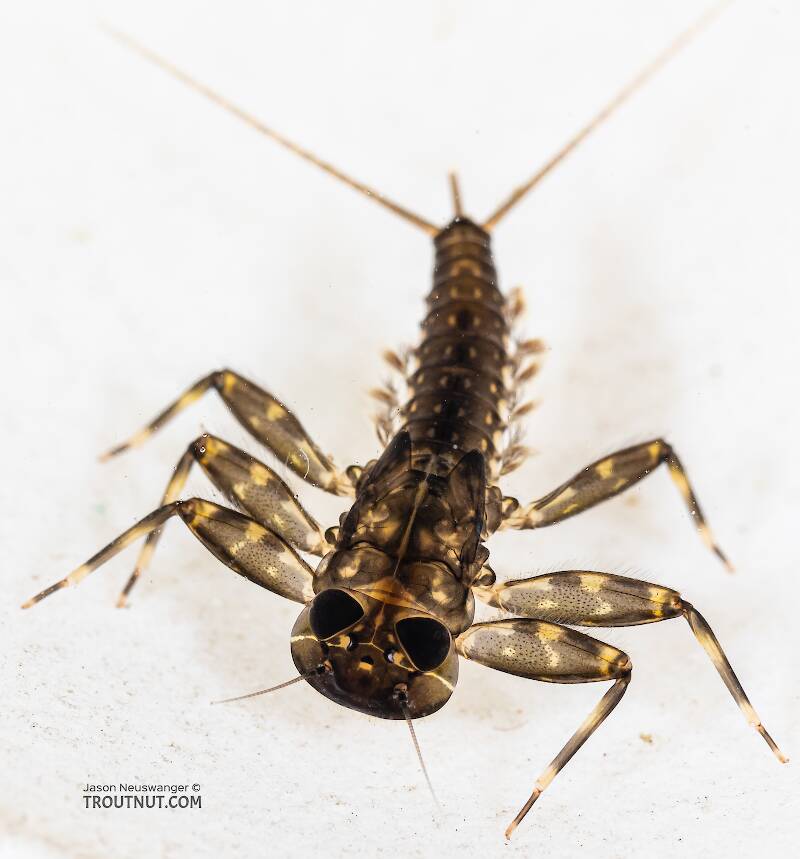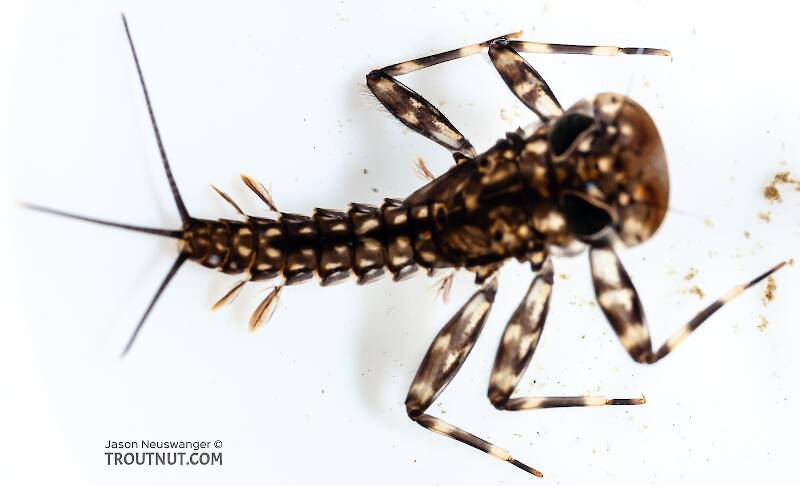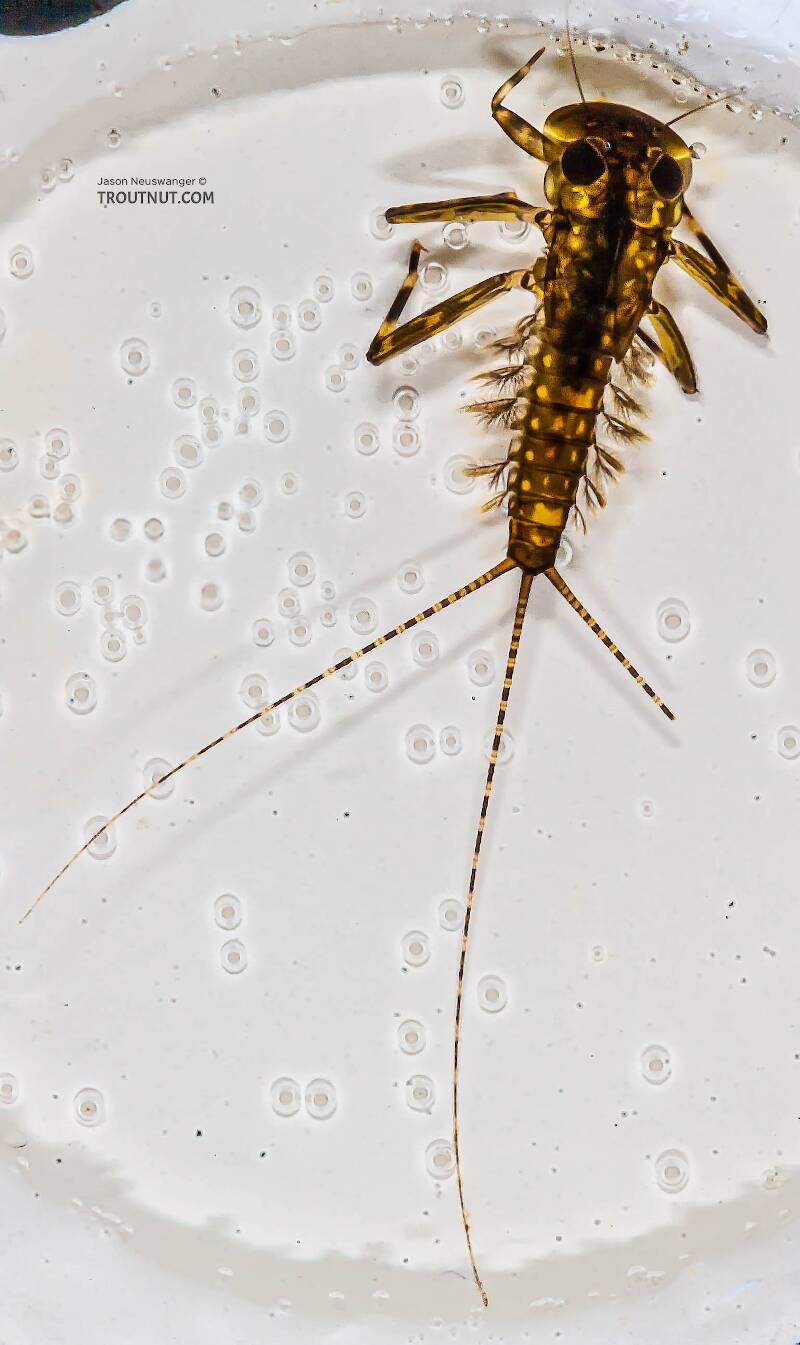
Hex Mayflies
Hexagenia limbata
The famous nocturnal Hex hatch of the Midwest (and a few other lucky locations) stirs to the surface mythically large brown trout that only touch streamers for the rest of the year.


Mayfly Species Heptagenia pulla (Golden Duns)
Where & when
There are conflicting accounts of the emergence dates for this species. The Leonards in Hatches II give June 2nd to August 4th as the dates for emergence in Michigan, while Caucci and Nastasi in Hatches II say it hatches from August through October. Knopp and Cormier say it hatches from mid-May through August. I don't know who is correct, but I have collected near-mature nymphs in June in northern Wisconsin.In 54 records from GBIF, adults of this species have mostly been collected during July (33%), June (28%), August (26%), and September (7%).
In 5 records from GBIF, this species has been collected at elevations ranging from 3 to 2096 ft, with an average (median) of 23 ft.
Species Range
Physical description
Most physical descriptions on Troutnut are direct or slightly edited quotes from the original scientific sources describing or updating the species, although there may be errors in copying them to this website. Such descriptions aren't always definitive, because species often turn out to be more variable than the original describers observed. In some cases, only a single specimen was described! However, they are useful starting points.
Male Spinner
Wing length: 10-11 mm
Mesonotum light reddish brown; abdominal tergites largely dark reddish to purplish brown, sternites with median reddish shading; genitalia as shown in fig. 94.
Frontal portion of head pale; a brownish transverse streak across carina below bases of antennae. Vertex dark brown. Pronotum dark brown. Remainder of thoracic notum paler reddish brown; a purplish brown streak above the fore coxa, more or less continuous with one of two dark marks anterior to wing roots. Pleura yellowish; above and on each side of middle and hind coxae are two dark spots; faint dark markings between middle and hind legs. Sternum pale reddish brown. Fore femora and tibiae yellowish, tips reddish brown; in fresh specimens, both joints often washed with red-brown. Basal fore tarsal joint about 1/6 the length of the second. Tarsus whitish, joints faintly reddish. Middle and hind legs pale yellowish white; ‘knees’ reddish; claws and distal tarsal joints tinged with red. Basal tarsal joint of hind leg shorter than second one. Wings hyaline; longitudinal and cross veins brown, the latter somewhat thicker than longitudinals in anterior portion of fore wing. Stigmatic area somewhat opaque, clouded, 6 to 7 basal costal cross veins, about 15 beyond bulla.
Abdominal segments 1-6 semi-hyaline; 7-10 opaque. Tergites largely dark reddish to purplish brown, leaving the antero-lateral angles whitish. A narrow pale mid-dorsal line and pale lunate submedian marks on each tergite; posterior margins darker purplish brown. Apical tergites tinged with yellowish red. Sternites 1-6 pale yellowish white; posterior margins rather widely reddish, mid-ventral area tinged with pinkish or light red. Abdomen appears annulate, due to dark posterior margins of segments. Tails pale whitish, joinings distinctly dark red-brown. Penes rose-pink at tips. The species is allied to Heptagenia julia, but it is considerably larger; the two pairs of median spines on penes are unequal in size, while in julia all four spines are approximately equal. The western Heptagenia solitaria is apparently very close to this species, also.
Specimens of the Mayfly Species Heptagenia pulla
3 Nymphs
Discussions of Heptagenia pulla
Start a Discussion of Heptagenia pulla
References
- Caucci, Al and Nastasi, Bob. 2004. Hatches II. The Lyons Press.
- Jacobus, L. M., Wiersema, N.A., and Webb, J.M. 2014. Identification of Far Northern and Western North American Mayfly Larvae (Insecta: Ephemeroptera), North of Mexico; Version 2. Joint Aquatic Science meeting, Portland, OR. Unpublished workshop manual. 1-176.
- Knopp, Malcolm and Robert Cormier. 1997. Mayflies: An Angler's Study of Trout Water Ephemeroptera . The Lyons Press.
- Leonard, Justin W. and Fannie A. Leonard. 1962. Mayflies of Michigan Trout Streams. Cranbrook Institute of Science.
- Needham, James G., Jay R. Traver, and Yin-Chi Hsu. 1935. The Biology of Mayflies. Comstock Publishing Company, Inc.
Mayfly Species Heptagenia pulla (Golden Duns)
Species Range
Common Names
Resources
- NatureServe
- Integrated Taxonomic Information System
- Global Biodiversity Information Facility
- Described by Clemens (1913)




